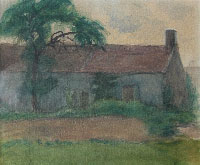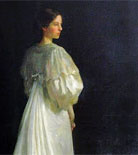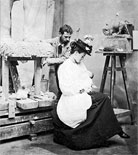AWARDS
- Académie Julien, Paris, France, Medal and Prize, Dog with Bone, 1894
- American Academy of Rome, Friend, Prix De Rome, 1926-27
- Architectural League, New York City, Gold Medal of Honor, Princeton Tiger, 1911
- Bohemian Club, Trap Shooting Tournament Winner, 1921
- Camp Fire Club of America, for Eminent Service, 1948
- Camp Fire Club of America, Man of the Year, 1946
- Columbian Exposition, Chicago, IL, Designer Medal for special contribution of 37 pieces including:
- Polar Bear, Moose, Buckaroo and On the War Trail, 1893
- Louisiana Purchase Exposition, St. Louis, MO, Gold Medal (Louis Jolliet), 1904
- Panama-Pacific International Exposition, San Francisco, CA, Gold Medal, 1915
- Pan-American Exposition, Buffalo, NY, Bronze Medal for watercolor, 1901
- Paris Exposition, Gold Medal for Sculpture Indian Warrior, Quadriga and Puma, American Pavilion, 1900
- Watercolor Society of New York, Second Place for Painting, 1889
HONORS
- Judge, Pendleton Roundup, Pendleton, OR, 1916
- Judge, Seattle Stampede and Frontier Days, Wild West Show in Seattle during Potlatch, 1915
- Judge, National Academy of Design, Ninetieth Annual Exhibition, Galleries of the American Fine Arts Society, NY, 1915
- Member, Louisiana Purchase Exposition, Jury of Selection for Sculpture, St. Louis, MO, 1904
- Member, Pan-American Exposition, Jury of Selection of Awards and Sculpture, 1901
- Member, Paris Exposition, Jury of Selection of Sculpture, 1900
MEMBERSHIPS
- Adventurers’ Club
- American Fine Arts Society
- American Society of Animal Painters and Sculptors
- American Society for the Promotion of Art and American Artists
- American Watercolor Society
- Architectural League
- Art Commission New York
- Bohemian Club
- Boone and Crockett Club
- Camp Fire Club of America
- Canadian Art Club
- Century Club of New York, 1901-1950, 1975
- Committee, Promotion of Roosevelt Ideals of Roosevelt Memorial Association
- National Academy of Design
- National Art Club of New York
- National Council, Boy Scouts of America
- National Institute of Arts and Letters
- National Sculpture Society
- New York Art Commission
- New York Zoological Society
- Roosevelt Pilgrimage
- Smithsonian Robson Expedition, 1911
- Society of American Artists
- Sons of Colonial Wars
- Sons of the Revolution
- St. Francis Andrews Society
Alexander Phimister Proctor
A Timeline of Alexander Phimister Proctor's Life
-
September 27, 1860

Born in Bosanquet, a township in Ontario, Canada, to Alexander Proctor and Tirzah Smith-Proctor. The fourth child of 11, and the last to be born in Canada.
-
1864-1870
Family moves to Clinton, Michigan by covered wagon, and in the following eight years lives in Newton and Des Moines, Iowa.
-
1871
Family crosses the prairie to live in Denver. Proctor is baptized and pledges never to drink alcohol or smoke tobacco (a pledge he kept his entire life)
-
1876

At age 16, Proctor kills an elk and a bear in the same day. Dissects, studies and sketches each animal.
-
1879
Receives commission for 20 illustrations for the book Hands Up, written by Sheriff Dave Cook, the most noted peace officer in Colorado at the time.
-
1884
Hunts and sketches in Yosemite for six months with friend Alden Sampson. While there, Proctor and Sampson climb and reinstall cable hand-holds on top fifteen hundred feet of Half Dome. After completing this difficult challenge, Proctor is determined to become a successful sculptor.
-
1884-1885
Tries mining to strike it rich and pay for art training in New York City. The plan does not live up to expectations, so Proctor sells his Colorado homestead to fund education.
-
NOVEMBER 1885-1887
Studies at National Academy of Design and the Art Students’ League.
-
FALL 1887
Meets fellow sculptor John Rogers, who encourages Proctor to start on the model of Fawn in wax. Photograph of Fawn model appears in Harper’s Weekly, and the plaster is shown at the annual Century Club exhibit. While sketching at the menagerie in New York, Proctor develops the ability to retain an action picture in his mind by closing his eyes, opening them for a split second, and shutting them again.
-
WINTER 1888-1889
Opens first studio, with W.W. Deming, in New York. Learns that the Greeks and Egyptians fashioned their own tools, and decides to make his own tools to increase his modeling control. Noted New York art dealer N.E. Montross handles some of Proctor’s paintings.
-
SPRING 1890
Visits family in Snohomish, Washington; hunts and sketches bear and elk in Alberta, Canada.
-
SUMMER 1891
Hunts and sketches in the Cascade Mountains. Receives telegram inviting him to participate in the Columbian Exposition in Chicago.
-
SEPTEMBER 1891

Arrives in Chicago to begin his first big commission: 37 models for the Columbian Exposition. While there, he meets renowned sculptor Augustus Saint-Gaudens and Margaret (Mody) Daisy Gerow, a painter and sculptor working for Lorado Taft.
-
SEPTEMBER 27, 1893

Marries Margaret “Mody” Gerow.
-
OCTOBER 1893

Sails for Paris to study French methods of sculpture at the Académie Julien. Also studies under Denys Pierre Puech and Jean Antoine Injalbert at Académie Colarossi. Wins first prize at annual competition in Paris for The Boxer-Pug. Prize is a 100 golden franc piece.
-
SPRING 1894
Receives telegram from Saint-Gaudens asking him to model the horse for a statue of General Logan to be placed in Chicago.
-
AUTUMN 1894
Accepts commission; returns to New York City to work with Saint-Gaudens.
-
AUGUST 1895
Creates another horse for Saint-Gaudens; this time he sculpts General Sherman’s horse, which now resides in Central Park, New York City.
-
AUGUST-SEPTEMBER 1895
Trip to Montana with Henry Stimson (later to become U.S. Secretary of State) to sketch, hunt and review area for a national park.
-
1896

Begins work on Standing Pumas for Prospect Park, Brooklyn, New York. Visits Blackfoot Indian reservation in Montana to sketch and model Indians and animals.
-
FALL 1896

Receives the Rinehart Scholarship, which funds three years of study in Paris. While in France, he meets many French sculptors, works on puma sketches and models the Indian Warrior for the Rinehart Committee.
-
1898
Receives commission to do the Quadriga for the American Pavilion at the International Exposition of 1900 in Paris, France. Returns to Paris.
-
AUTUMN 1898
Returns to New York. Awarded the Prix de Rome, which he turns down because it would mean doing classical statues.
-
FALL 1900
Returns to New York. Receives commission for sculptures to be exhibited at the Pan-American Exposition, Buffalo, New York.
-
1901-1902
Exhibits nine small bronzes, mostly animals, at the Pan-American Exposition, Buffalo, New York.
-
1902

Completes Sentinal Lions for the Frick Building, Pittsburgh, Pennsylvania.
-
1903

Receives commission for a copper griffin for the Louisiana Purchase Exposition of 1904, St. Louis, Missouri. Also creates a sculpture of Louis Jolliet for the Exposition. Makes a number of models for the House of Primates at the Zoological Park, New York City.
-
1906

Completes Lions for McKinley Monument and completes the decorations for the elephant house at the Bronx Zoo. Receives commission for two tigers for the entrance to Nassau Hall, Princeton University.
-
1907

Receives commission to do four tigers for the 16th Street Bridge in Washington, D.C. Works on Buffalo Heads for State Dining Room in the White House.
-
1908
Receives commission for bronze Bison Keystones for the Arlington Cemetery Bridge, Washington, D.C.
-
SPRING 1909
Hunts and sketches in Canada’s Banff and Waterton Lakes areas. Meets George Pratt and his brother Herbert Pratt. Herbert commissions two Tigers and one four-foot Buffalo for his estate at Glen Cove, Long Island, New York.
-
FALL 1910
Antelope hunting trip to Edmonton with Alden Sampson.
-
1911

One-man show at the Portland Art Museum, Portland, Oregon. Receives commission for four, large bronze Buffalo for the Q Street Bridge, Washington, D.C. Visits 200,000-acre Wainwright game preserve to study and sketch buffalo.
-
SUMMER 1912
Hunting trip with George Pratt to Alberta.
-
SUMMER 1913
Big game hunting trip to Fort Steele, British Columbia, with George Pratt to gather specimens for the Smithsonian.
-
SPRING 1914
Works on Indian Pursued. Chief Little Wolf, a Cheyenne Indian, poses for the sculpture. Proctor performs secret ceremony to become a blood brother to Chief Little Wolf.
-
1915

Travels to Portland, Oregon to work on several bas-reliefs. Attends a round-up in Pendleton, Oregon. Starts The Buckaroo. Completes work on small bronze Indian head called Jackson Sundown. Homesteads 120 acres near William Hanley’s ranch. Hanley is cattle king of Eastern Oregon, and later U.S. senator.
-
SPRING 1916
Completes the buffalo portion of the Buffalo Hunt and then selects Jackson Sundown, nephew of Chief Joseph, as the model for the statue’s horse rider.
-
SUMMER 1916

Moves to Lapwai, Nez Perce reservation with Mody and their seven children to model Jackson Sundown. Camps with the Indians in a tepee.
-
1917

Receives commissions for Bronco Buster, On the War Trail, Pioneer and Mohawk Indian.
-
SUMMER 1918
Moves to Palo Alto, California. Needs a larger studio, so Stanford University leases Proctor a room in the engineering building.
-
1919

Drives 1500 miles to Browning, Montana, in search of a new model for On the War Trail and Mohawk Indian. Spends the summer at Many Glacier modeling Blackfoot Indians. Returns to California in late fall with Big Beaver, his model, to complete On the War Trail.
-
1920

Receives commissions for The Rough Rider and Circuit Rider.
-
1923
Sells Palo Alto home and moves to Hollywood, California. He knows he can find models from movie sets for the recent commission for the Pioneer Mother group.
-
1925
William Mitchell Kendall, chairman of the American Academy in Rome, offers Proctor a studio at the Academy. Proctor accepts and becomes their Resident Sculptor.
-
OCTOBER 1925
Arrives in Rome.
-
1927

The Pioneer Mother project is cast in bronze in Rome and transported to Kansas City, Missouri.
-
1927-1928
Travels to Brussels, Belgium.
-
SUMMER 1928
Returns to U.S. and settles in Wilton, Connecticut.
-
1929
Receives commission for General Robert E. Lee and Young Soldier.
-
JUNE 12, 1936

General Robert E. Lee and Young Soldier dedicated in Dallas, Texas with President Franklin D. Roosevelt unveiling the statue.
-
1936
Sells Wilton, Connecticut home and moves to New York City.
-
1936-1938
Works on drypoint etchings of wild animals. Mody has heart problems.
-
SEPTEMBER 1936
Bear hunting trip to Southeastern Alaska. Shoots his limit of four bears.
-
1937
Proctors move to Seattle, Washington. Receives commission for Mustangs for the University of Texas, Austin.
-
1939
Lives for a year at Rancho Los Palos, Texas, while modeling a stallion, five mares and a colt for Mustangs.
-
1940
Moves to North Bend, Washington.
-
1941
Begins serious work on autobiography, Sculptor in Buckskin, and continues to sketch and paint.
-
1942
Mody Proctor dies.
-
1943
Proctor moves back to Palo Alto, California.
-
SEPTEMBER 1946

Hunts in Alaska. Kills a bear 69 years after killing his first bear at age 16-two days before his 85th birthday.
-
1948

The Mustangs completed in 1939 are finally cast, following the World War II bronze shortage.
-
SEPTEMBER 1950

Dies in Palo Alto at the age of 89.
Proctor was born on September 27, 1860, in Bosanquet, Ontario, to Alexander and Tirzah (Smith) Proctor, the fourth in a family of eleven children. His family moved to Michigan, Iowa, and before settling in the Pacific Northwest, lived in Denver, Colorado for six years. During he Colorado years, Proctor developed a love for hunting and sketching wild animals. He was a genuine Westerner whose love of the American wilderness — its social and natural history — never left him.
His formal artistic training began in Denver, continued at the Art Students’ League, the National Academy of Design in New York City, and later at the Académies Julien and Colarossi in Paris. While in Paris, he learned to translate his keen observations into works of art that memorialized the West without sentimentality.
Proctor summed up his outlook on life best at the end of his autobiography, Sculptor in Buckskin: “I am eternally obsessed with two deep desires-one, to spend as much time as possible in the wilderness, and the other, to accomplish something worthwhile in art.”
He did both to an enviable extent. Proctor was a rare individual who viewed life as work and work as play. To him, hunting and sculpting were indelibly intertwined. Hunting was his breath of life and the inspiration and education for the sketches and models that would become revered sculptures.
In 1891, the great Polish pianist Ignace Jan Paderewski paid a visit to Alexander Phimister Proctor’s studio on the site of the World’s Columbian Exposition in Chicago, where Proctor was working on life-sized wild animal sculptures. The pianist admired Proctor’s Stalking Panther and Fawn bronzes commenting that he couldn’t understand how the same man could model so fierce a beast as a panther and such a delicate, timid fawn. Always the charmer, Proctor countered by wondering how Paderewski could play a crashing thunderstorm and then a dainty sonata to a water lily. Paderewski replied, “I interpret; you create.”
Alexander Phimister Proctor died September 5, 1950, but he lived his nearly 90 years to the fullest. He was active in his studio until two weeks before his death, and lived up to his adventurous reputation, by shooting bears in Alaska at 84 years of age.
Proctor dedicated his life to creating monumental statues throughout the United States. His works of art celebrate both famous heroes and anonymous, iconic figures. General William T. Sherman rides a Proctor horse in Central Park, Pioneer Mother resides on the campus of the University of Oregon, and an equestrian group of the same name in Kansas City, honors the dauntless character of the West’s early pioneers. In Denver, the Bronco Buster and On the War Trail embody untamed frontier spirit. And, Proctor’s tribute to Theodore Roosevelt, The Rough Rider, was the subject of the Metropolitan Museum of Art’s first educational film on the work of a sculptor.
Proctor gave much effort to making available his smaller bronzes to the general public. His work has been avidly included in private collections. Museums from coast to coast proudly display Stalking Panther, Fawn, Pursued, Arab Stallion, Buckaroo, Indian Warrior, and Buffalo Hunt.
Proctor’s genius in depicting animals can be seen in the Tigers in front of Princeton University’s Nassau Hall. The Animal House in New York’s Zoological Gardens carries his monkeys, elephants, rhinoceros and frogs on its frieze. Lions flank Pittsburgh’s Frick Building, and four Buffalo guard the Q Street Bridge in Washington, D.C. His last monumental commission, Mustangs, which resides on the campus of the University of Texas at Austin, is a sublime symbol of freedom and self-reliance–a fitting finale to a spectacular career.

